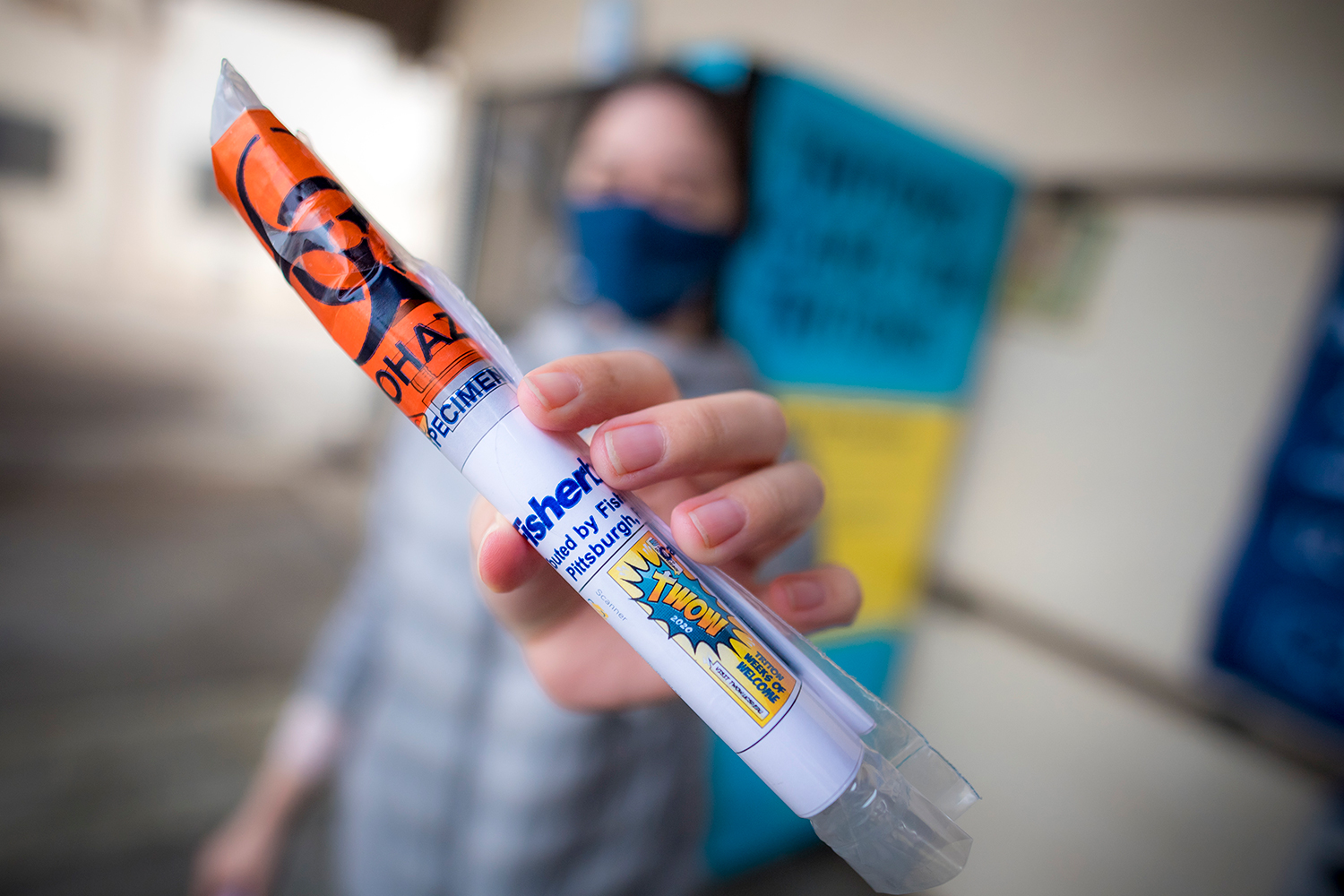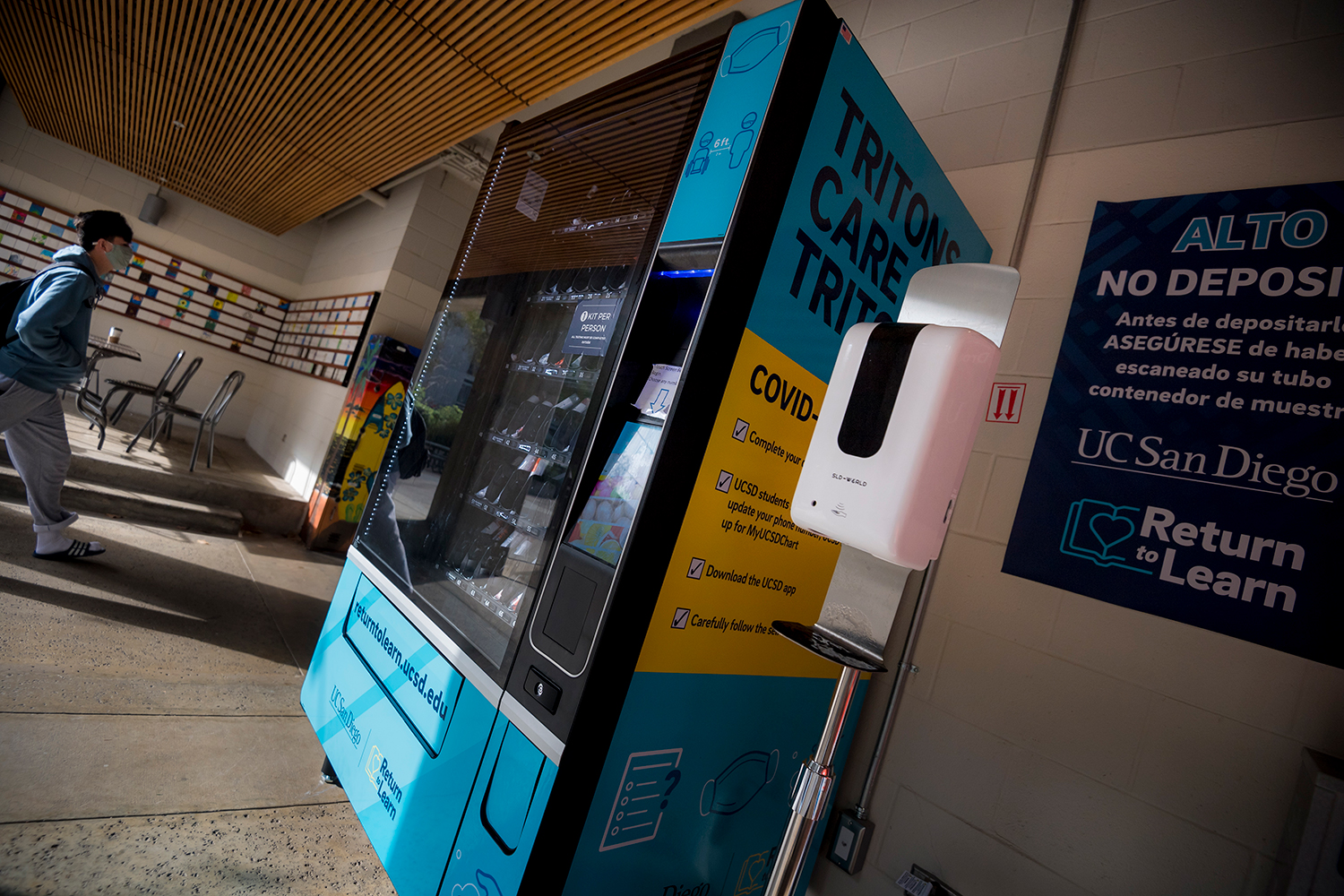UC San Diego COVID-19 Case Rates Drop Dramatically to Fall Quarter Levels
Campus mitigates surge with COVID test kit vending machines, wastewater monitoring, and contact tracing
Published Date
By:
- Christine Clark
Share This:
Article Content
Story updated Jan. 27, 2021
With the fourth week of winter quarter underway at the University of California San Diego, COVID-19 case rates have fallen dramatically since classes resumed on Jan. 4. The current test positivity rate on campus has reduced to pre-break levels of less than one half of one percent of students, far below the San Diego County average of about 10%. Through successful implementation of the nationally recognized, evidence-based Return to Learn program, the campus made pre-emptive adjustments in its protocols to detect and mitigate potential surges as early as possible.
As a result, the number of students living on campus who tested positive has dropped precipitously since the start of the quarter, with 89 students testing positive the week of Jan. 4, 30 students testing positive the week of Jan. 11, and 18 students testing positive the week of Jan. 18. Case levels are now close to those seen during the fall term, at about two to five cases per day.
To combat the anticipated uptick in cases from students returning from holiday travels, the campus increased mandatory testing from biweekly to weekly screening and increased access to self-administered tests by installing numerous COVID test kit vending machines throughout campus. The university also streamlined contact tracing efforts to move positive COVID-19 students swiftly into isolation housing and exposed students into quarantine housing. Additionally, with the most ambitious wastewater early detection program in the country, UC San Diego is rapidly adding to its 76 samplers, which will expand to 200 by the end of the term.

“Adaptability and innovation in our planning set UC San Diego apart from other universities during this latest COVID-19 surge,” said Chancellor Pradeep K. Khosla. “Testing protocols continue to evolve in response to community conditions, what we learn through practice, and what our predictive models tell us. For example, we anticipated a higher positivity rate when students returned to campus from the break, where they may have congregated with family and friends to celebrate the holidays. We increased testing frequency to weekly, and installed vending machines to dispense self-administered tests to increase access and convenience. Along with the use of isolation housing for positive cases and continued wastewater monitoring, the increased access and testing frequency have halted further spread on campus.”
Among the positive cases investigated for on-campus resident students, 83% were infected after going home for the holidays and tested positive upon their return, which the campus predicted. To address this expected challenge, students moving onto campus for winter quarter were required to test within 24 hours of their arrival. They were then mandated to test again on day five, and again on day 10 after their return.
“We continue to pay close attention to the surge in Southern California that has been underway since November and are sensitive to rising levels of the virus in communities nationwide,” said Dr. Robert “Chip” Schooley, professor in the Department of Medicine at the UC San Diego School of Medicine and co-lead of the Return to Learn program. “We anticipated that when people went home for winter break, they would be exposed to high levels of infection in their home communities, similar to what we saw after the Thanksgiving holiday.”
COVID-19 test kit vending machines are now the primary source of testing for students
The new campus vending machines were a major boon to enhanced testing protocols. They distribute up to 2,000 test kits a day and are in high demand from students, faculty and staff.
“Students are using the vending machines as the primary means of accessing COVID-19 testing and complying with weekly mandatory testing,” said Dr. Angela Scioscia, interim executive director for Student Health and Wellbeing.

Last quarter, the campus processed an average of 1,000 tests a day, and the number has significantly increased this quarter. For example, on Jan. 14, the campus processed 3,334 tests, a marked increase in testing capacity and utilization. Since Jan. 1, more than 40,000 student tests have been processed.
Results continue to be fast, often available the next day and sometimes even the same day, allowing positive students to rapidly be moved into isolation housing.
UC San Diego currently has 8,721 undergraduate and graduate students living on campus. The university also has dedicated more than 600 beds for isolation and quarantine housing, which have consistently had more than 80 percent availability. Students in the units have food delivery as well as other support services. Quarantine and isolation beds are also available to off-campus resident students who test positive.
In anticipation of the post-winter break surge, Cheryl Anderson, professor and founding dean of The Herbert Wertheim School of Public Health and Human Longevity Science at UC San Diego, streamlined contact tracing efforts.
“The goal of contact tracing is to interrupt transmission of the disease, and timeliness is critical,” Anderson said. “Rather than adding more staff, we focused on the data that is crucial to the mission of our contact tracing efforts—which is to find out who was exposed and infected so we could move them into isolation housing as soon as possible.”
Campus contact tracing efforts are augmented by CA Notify, the COVID exposure notification system piloted by UC San Diego. More than 25,000 campus members activated the technology—developed by Google and Apple—on their cell phone.
The university is currently evaluating travel guidelines for spring break, which will take March 20 to March 23.
For more information on Return to Learn, go to the program’s website.
Share This:
You May Also Like
Stay in the Know
Keep up with all the latest from UC San Diego. Subscribe to the newsletter today.



